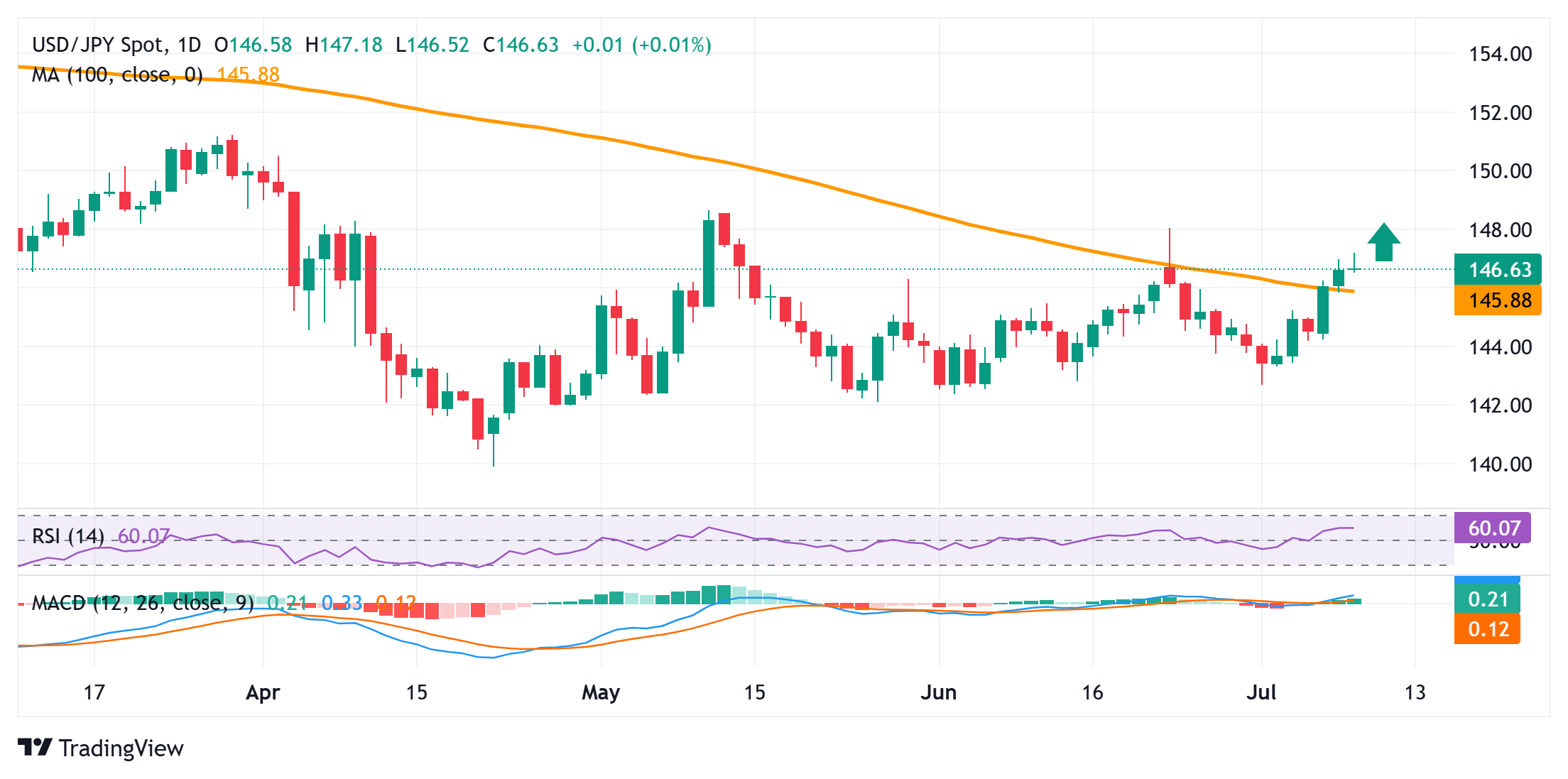
- USD/JPY advances to over a two-week high and draws support from a combination of factors.
- Trade jitter tempers BoJ rate hike bets and acts as a tailwind for the major amid a firmer USD.
- Traders now look forward to FOMC Minutes for rate-cut cues and some meaningful impetus.
The USD/JPY pair surrenders its intraday gains to a two-and-a-half-week high touched earlier this Wednesday and trades just above the mid-146.00s during the first half of the European session. Traders scaled back their bets for an immediate interest rate hike by the Bank of Japan (BoJ) amid concerns over the potential economic fallout from US President Donald Trump’s trade tariffs. This, along with a broadly firmer US Dollar (USD), turns out to be a key factor that should continue to act as a tailwind for the currency pair.
Trump unnerved investors earlier this week and announced that his administration will impose a 25% tariff on goods imported from Japan starting from a new deadline of August 1. Furthermore, Trump warned that any retaliatory levies would draw a like-for-like response and vowed to further escalate his trade wars, threatening tariffs of up to 200% on foreign drugs and 50% on copper. Meanwhile, Japanese Prime Minister Shigeru Ishiba said in a cabinet meeting on Tuesday that bilateral talks would continue towards seeking a mutually beneficial trade deal.
Nevertheless, the developments add to woes for Japan’s economy, which shrank in the first quarter on soft consumption. Adding to this, government data released on Monday showed that the growth in Japan’s nominal wages decelerated for the third straight month in May 2025 and inflation-adjusted real wages posted the steepest decline in 20 months. Moreover, rising trade tensions could complicate the BoJ’s monetary policy normalization schedule, which continues to undermine the Japanese Yen (JPY) and supports the USD/JPY pair amid some follow-through USD buying.
Investors now seem convinced that US tariffs will eventually feed through into higher prices and allow the Federal Reserve (Fed) to stick to its wait-and-see approach. Moreover, the upbeat US jobs report for June eased concerns about a slowing US economy and evaporated odds of a rate cut at the Fed’s upcoming policy meeting in July. This remains supportive of elevated US Treasury bond yields and assists the USD to stand firm near a two-week high. Furthermore, domestic political uncertainty undermines the JPY and contributes to the USD/JPY pair’s positive move.
Recent media polls raised doubts about whether the ruling coalition of the Liberal Democratic Party (LDP) and its junior partner Komeito will be able to secure enough seats to maintain their majority at the July 20 House of Councillors election. This could complicate trade negotiations and also heighten both fiscal and political risks in Japan, which, in turn, favors the JPY bears. Traders, however, might opt to wait for the release of FOMC meeting Minutes to get fresh insight about the Fed’s policy path before placing fresh bullish bets around the USD/JPY pair.
USD/JPY daily chart

Technical Outlook
The USD/JPY pair’s overnight sustained breakout and close above the 100-day Simple Moving Average (SMA) for the first time since February could be seen as a fresh trigger for bullish traders. Moreover, oscillators on the daily chart have been gaining positive traction and are still far from being in the overbought zone. This, in turn, validates the near-term positive outlook and backs the case for a further appreciating move towards the 147.60-147.65 intermediate hurdle en route to the 148.00 round figure, or the June monthly swing high.
On the flip side, weakness below the Asian session low, around the 146.50 area, could be seen as a buying opportunity and is more likely to remain limited near the 100-day SMA resistance breakpoint, currently pegged just below the 146.00 mark. The latter should now act as a strong near-term base for the USD/JPY pair, which if broken decisively might shift the near-term bias in favor of bearish traders and pave the way for some meaningful downside. The subsequent fall could drag spot prices to the 145.65-145.60 horizontal zone en route to the 145.00 psychological mark. The next relevant support is seen near the 144.35-144.30 area before the pair eventually drops to the 144.00 round figure.
Information on these pages contains forward-looking statements that involve risks and uncertainties. Markets and instruments profiled on this page are for informational purposes only and should not in any way come across as a recommendation to buy or sell in these assets. You should do your own thorough research before making any investment decisions. FXStreet does not in any way guarantee that this information is free from mistakes, errors, or material misstatements. It also does not guarantee that this information is of a timely nature. Investing in Open Markets involves a great deal of risk, including the loss of all or a portion of your investment, as well as emotional distress. All risks, losses and costs associated with investing, including total loss of principal, are your responsibility. The views and opinions expressed in this article are those of the authors and do not necessarily reflect the official policy or position of FXStreet nor its advertisers. The author will not be held responsible for information that is found at the end of links posted on this page.
If not otherwise explicitly mentioned in the body of the article, at the time of writing, the author has no position in any stock mentioned in this article and no business relationship with any company mentioned. The author has not received compensation for writing this article, other than from FXStreet.
FXStreet and the author do not provide personalized recommendations. The author makes no representations as to the accuracy, completeness, or suitability of this information. FXStreet and the author will not be liable for any errors, omissions or any losses, injuries or damages arising from this information and its display or use. Errors and omissions excepted.
The author and FXStreet are not registered investment advisors and nothing in this article is intended to be investment advice.








